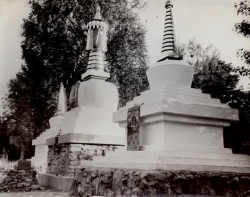Stupas in the Buddhist religion
The word Buddha means enlightened one. It is a name bestowed upon Siddhartha Gautama, an Indian prince, who lived around 2,500 years ago. He taught the liberation path from suffering. Buddhism teaches that the deliverance from suffering is possible by individual effort.
Stupas in the Buddhist religion are a symbol best defined as a spiritual monument. Stupas are small enough to place on a mantle or are huge buildings. The structure is a symbol of the path to enlightenment which encompasses the Buddha’s body, teachings and mind.
The structure of the monument represents the physical presence of Buddha. The base is square and represents Buddha’s throne. The design represents the Buddha’s crossed legs, torso, face, eyes and crown. A parasol or canopy at the top wards off evil, and a walking path surrounds the base. People of high spiritual attainment are commemorated by stupas, and building stupas is a spiritually beneficial act.
The base embodies qualities that the Buddha taught. Steps upward from the base symbolize spiritual anchors for the mind and soul. Authority, spiritual riches, virtues and the tree of life are symbolized.
The tree of life is placed in the center of the stupa. Gems and thousands of mantras cover a wooden pole. During the dedication ceremony, participants direct positive thoughts and wishes towards the tree of life. The positive thoughts are stored inside the tree of life. The positive energy activates the tree of life inside the stupa.
Specific qualities are associated with stupas in the Buddhist religion. The path to enlightenment and the end of suffering includes concentration, perseverance, mindfulness, wisdom, effort, equanimity, flexibility and joy.
The structural symbolism includes the eight great deeds of Buddha including his birth, miracles and enlightenment. The five elements of earth, water, air, fire and space are incorporated. The sun and moon at the top of the structure signifies the end of suffering and the spiritual quality of compassion towards all life.
Stupas are built with specific intentions in mind. Purposes are to honor the remains of the Buddha and other high spiritual people or to hold objects like a robe or begging bowl. Other stupas honor life events of the Buddha, promote Buddhist teachings or provide a place for meditation.
The symbolism is multi-layered, and the structure itself conveys spiritual liberation. The entire design of stupas in the Buddhist religion, and the meaning behind the design, is to teach people how to eliminate suffering and radiate enlightenment.

